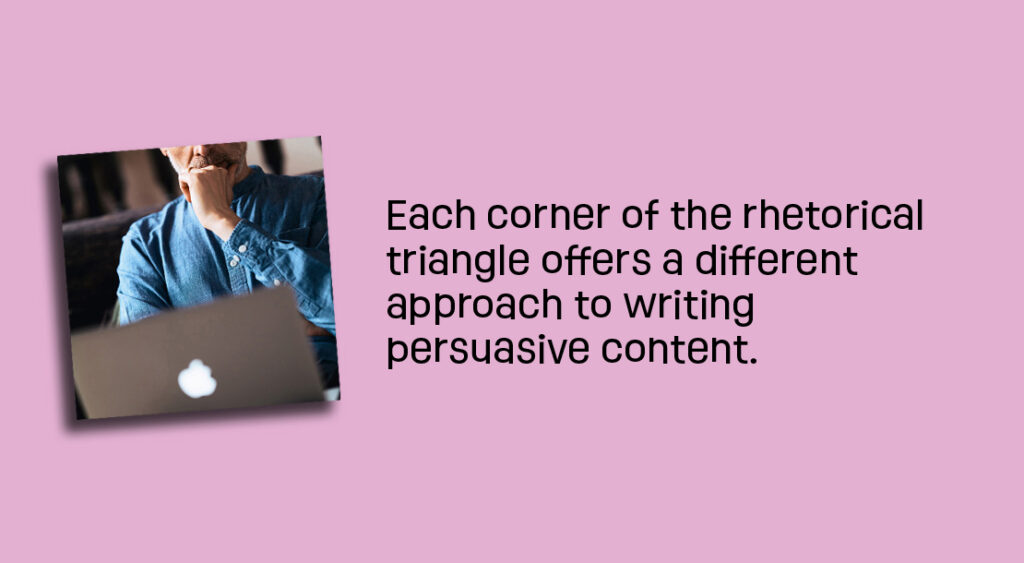Rhetoric is the perfect copywriting tool for creating compelling content. Language that uses rhetoric is persuasive and persuasion is a vital ingredient in the marketing mix.
The first time I can remember hearing about rhetoric, I was at school. I was studying Shakespeare’s Julius Caesar for my O-level English Literature exam. At the time, I’m not sure I really got it (I was 15 years old and Shakespeare was definitely not at the top of my list of interests).
But more about Shakespeare later. The first point I want to make is that rhetoric isn’t something you only associate with literature. It’s a highly effective copywriting tool for 21st-century marketers.

Rhetoric goes back a long way, to Ancient Greece in the 5th century BC. Rhetors taught their students public speaking and how to use rhetoric. Public speaking was a crucial element in education and rhetoric was at the heart of the process.
The classical rhetoricians invented stylistic aspects of speaking and later, writing, such as metaphor. Fast forward to now and rhetoric has basically come to mean using persuasion in speaking or writing.
But if, for marketing purposes, you narrow rhetoric down to this, how does it work in practice?
There are three rhetorical methods for persuading an audience:
Let’s look at each one from a marketing perspective.
Logic, in the context of applying rhetorical devices to marketing, isn’t purely fact-based. Instead, you’re tapping into your target audience’s beliefs and expectations.
What do they believe to be true about your product or service and how can you reinforce these beliefs to make them feel self-evident and therefore actionable?
Example: building a business case argument
“90% of clients confirm our social media engagement programme has increased customer spending by 20-40%. Social media works if you use a tried and tested system to harness its potential.”
Building trust is vital for establishing yourself as your target audience’s go-to brand.
Ethos is all about showing your credibility and authority to reinforce the persuasive power of your content. It isn’t about boldly stating you’re the best but demonstrating your credibility through knowledge, insight and experience.
Example: building industry credibility with a case study
“This is how we applied our branding knowledge and marketing expertise to transform a local cleaning business into a trusted office hygiene brand for B2B workspaces.”
Emotions impact decision-making, even business decisions.
People might like to think they make coolly rational decisions, but the heart tends to overrule the head. Emotions drive decisions.
And business decision-makers are no different to consumers when it comes to emotions – in fact, research shows they are more driven by emotions.
Using pathos, you can connect with these emotions to compel your audience to act.
Example: building an emotional connection to grow a brand
“You’re struggling to balance marketing your business with the day-to-day demands of working in it. The pressure’s on. You can’t do everything at once. But we can give you the reassurance of strategic and on-demand marketing support as if we were your own in-house team.”
Each corner of the rhetorical triangle – logos, ethos and pathos – offers a different approach to writing persuasive content.
Which you choose will depend on how you feel you can best appeal to your target audience.
Your use of rhetoric should also tally with your brand personality, to keep your messaging consistent and maximise its persuasive impact.
There aren’t hard and fast rules to this – but like any tool, rhetoric depends on how well you use it.
Okay, so this isn’t really a case study, but it does show rhetoric can stir an audience to action.
Remember I mentioned Shakespeare’s Julius Caesar at the beginning of this blog? It contains a famous example of rhetoric, Mark Antony’s funeral speech after Caesar’s assassination.
It’s the one that begins with this famous line:
“Friends, Romans, countrymen, lend me your ears…”
Yes, it might seem over-familiar, even a little corny, but from a marketing perspective, it’s a performance that really does the business.
Mark Antony begins his speech under restricted conditions – the conspirators have only allowed him to speak providing he doesn’t bad-mouth them.
Plus, the audience is currently anti-Caesar, following Brutus’s public justification of the assassination.
But with his rhetorical skills, he turns the tables and upends the situation entirely. By the time he’s finished, he has the audience exactly where he wants them. He wins them over to his viewpoint by appealing to their emotions.

He doesn’t tell them what he thinks they should do. Instead, he makes them feel differently about Caesar and this drives the transformation in their beliefs.
That’s a marketer’s dream.
Rhetoric is one of many tools copywriters use to persuade audiences to act.
Want to see persuasive copywriting in action, driving transformation in your brand and growing your business?
07896711853
[email protected]